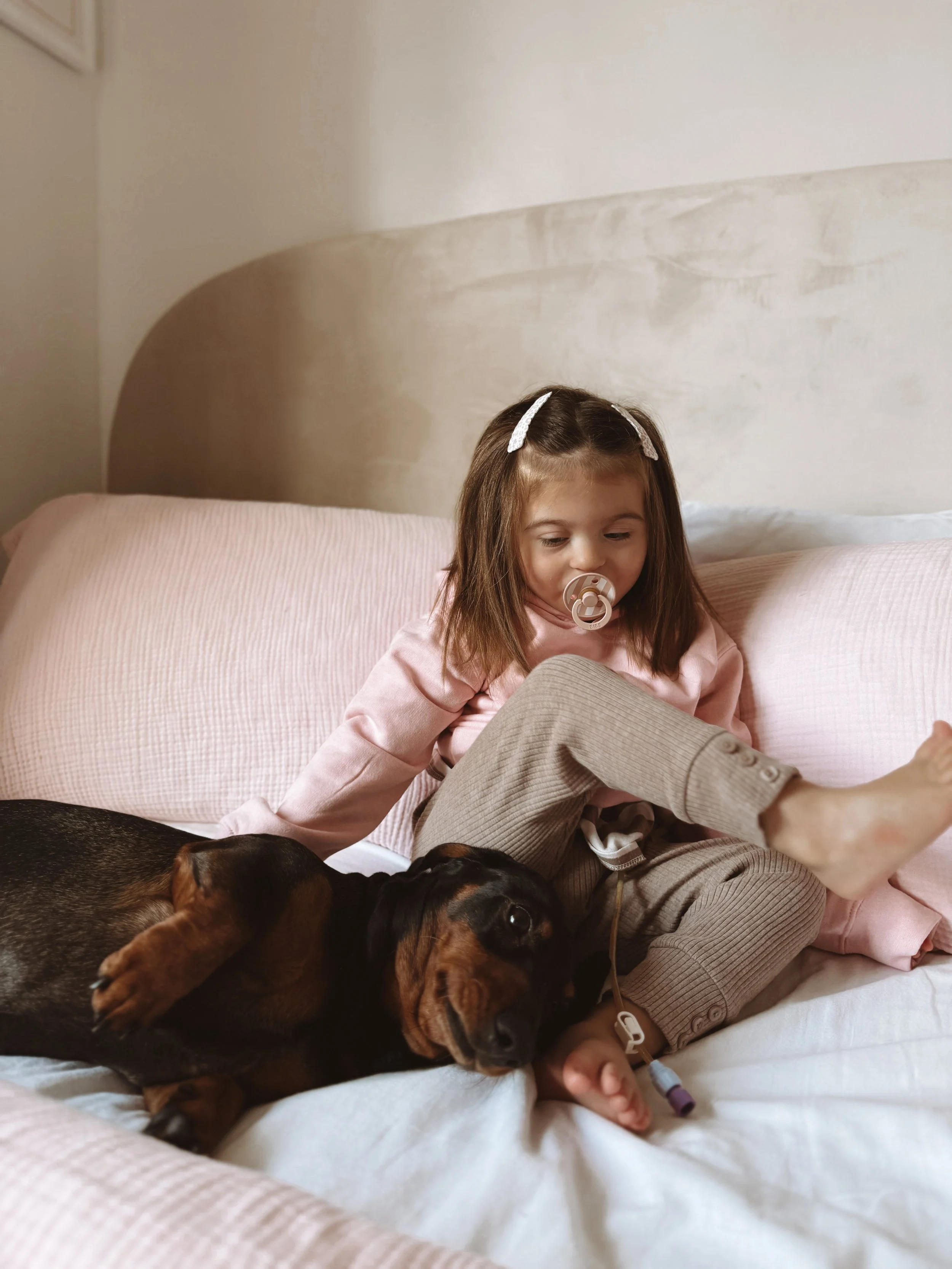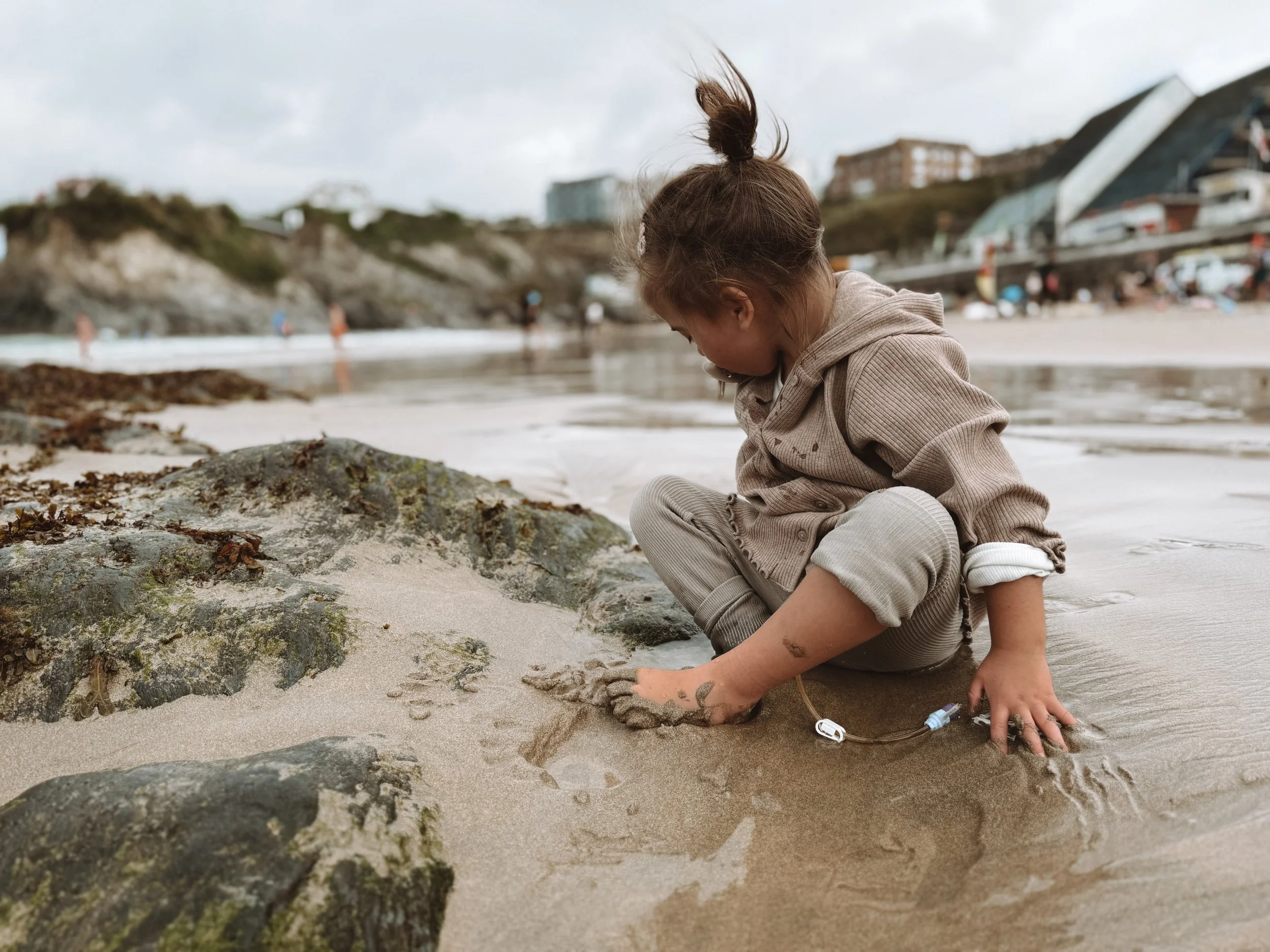Relief, Not Defeat
How one mum learned to see her daughter’s feeding tube as a lifeline – not something to fear.
Nicole Keenan lives in the UK with her mum, Sharon, her three-year-old daughter, Bonnie Luella, and their cheeky eight-year-old dachshund, Pete. Like many parents navigating the unpredictable world of complex medical needs, Nicole has learned that things don’t always go to plan – and that’s okay.
“Looking back, I remember the fear and grief I felt at first, wishing things could be different,” Nicole says. “Now, I feel nothing but gratitude for the tube. It doesn't define her, but it allows her to thrive.”
Here, Nicole shares candidly on their tube-feeding journey – the messy car seat moments, the stares from strangers – and why she’s determined to help other families feel a little less alone in it all.
When did tube-feeding start happening for your family, and how did you feel about this at the time?
Bonnie was born prematurely at 34 weeks and, although I always knew she was a fighter, we quickly realised her journey would look very different from what I’d once imagined. She has a rare genetic condition – MED13L syndrome – and a cleft palate that wasn’t discovered until she was eight months old.
I knew something wasn’t right long before then, but it took months of worrying and pushing before the cleft was finally found.
Tube-feeding became part of Bonnie’s story almost immediately. She had a nasogastric (NG) tube placed the day after she was born, in January 2022, and she kept it in for ten days. After that, we were allowed home, but she always struggled with feeding.
At around two to three months old she was put on a high-calorie, weight-gaining milk. Deep down, I knew something wasn’t right. But as a first-time mum, I didn’t know what was “normal” and what wasn’t – and nobody offered us an NG tube again.
I felt lost in those early months, like I was missing something important.
Her cleft was repaired when she was 13 months old. Alongside feeding difficulties and developmental delays, this all led us back to tube-feeding – something I never thought would become such an essential part of our family’s life.
After a long fight – with milk and food from weaning coming out of her nose, endless speech and language therapy and feeding therapy – Bonnie developed a strong food aversion.
This didn’t help, as she relied heavily on her high-calorie milk and wouldn’t take any other type. She also wouldn’t drink water, which left me constantly worrying she was dehydrated. She was often poorly and, eventually, we were sent for a videofluoroscopy, which revealed that she aspirates. We were sent away with thickeners, but they didn’t help.
On 15 January 2025 – just two days before her third birthday – Bonnie had her Freka PEG fitted. That date will stay with me forever because, while it was daunting, it also meant relief.
The truth is: fed is best. However feeding looks – whether by mouth, bottle or tube – what matters is nutrition, health and happiness.
What does eating look like for Bonnie now?
She does still try purées first by mouth but, because of her weak oral muscles, she can’t chew and swallow effectively. That’s where her PEG comes in: as backup, as hydration, for her medication, and for those days when feeding by mouth just isn’t possible.
Knowing it’s there takes away so much stress. I can meet her needs without fear she’ll become dehydrated, lose weight or aspirate – which she does struggle with.
How do you feel about Bonnie tube-feeding nowadays, in comparison to how you used to feel about it?
Looking back, I remember the fear and grief I felt at first, wishing things could be different. Now, I feel nothing but gratitude for the tube. It doesn’t define her, but it allows her to thrive.
What helped you to get comfortable with tube-feeding – both practically and emotionally?
Practically, there are a few things that have made life easier. Vests have been a must – we found a lovely set from Growing Tots that have been the best ones for us. Accessibility is still a challenge as it’s hard to find clothing that works well with tubes. Tubie pads have also helped a lot, especially as Bonnie suffered with overgranulation around her site. Those small items make a big difference.
Emotionally, nothing really prepares you. You just have to do it. You learn on the job, sometimes in the messiest and most stressful of ways. But when you see your child happier, stronger and safer, you know it’s worth every bit of it.
What are the biggest challenges you've faced – and maybe still face – in your tube-feeding experience?
One of the biggest challenges has been the medical side – things like Bonnie’s overgranulation around her PEG site, which caused her a lot of discomfort, and the fact that she aspirates, which makes oral feeding risky.
On a practical level, clothing has been a challenge – finding vests that actually work for her tube, carrying supplies everywhere, or dealing with pumps that seem to beep at the worst possible times. And then of course there are the funny-but-stressful moments.
Emotionally, the hardest part is the constant reminder that feeding isn’t simple for her. People often stare or make comments when we’re out and there’s still such a lack of awareness about tube-feeding. It can feel isolating, but it has also made me stronger and more determined to advocate for her.
What are your go-to tube-feeding accessories, communities and/or resources?
Our go-to accessories have definitely made tube-feeding life a little easier. We love Sew and Zoe tummy pads and By Hugo button pads, accessories and bags – they’ve been brilliant for comfort and making things more manageable day-to-day. Growing Tots vests have been a lifesaver too, especially since it can be so difficult to find clothing that works properly with a tube.
On the support side, my dietitian has been amazing with helping us adjust feeds and make sure Bonnie is getting what she needs. And our community nurse has been such a big help, especially with practical things like grip locks and keeping everything secure.
Beyond that, Instagram and connecting with other tube-feeding families has been a huge support. Speaking to parents who really “get it” – who can offer advice, share tips and remind you you’re not alone – has been just as valuable as any product. Sometimes that message from another mum at the right moment makes all the difference.
Can you tell us about the funniest, messiest or most awkward tube-feeding situation you've found yourself in?
The messiest and funniest moments always seem to happen when we’re out and about with no spare clothes. Bonnie has a habit of unclipping her stopper which means her stomach contents end up squirting everywhere – usually all over me! It’s happened in shops, in the car and, once, right before we were about to meet friends. At the time it’s stressful and awkward, but afterwards I can laugh about it.
Another memorable one was when milk leaked all through her car seat during a feed. I didn’t realise straight away, so by the time we got home everything was soaked and it took ages to clean up. Now I double-check the line every single time before we set off! Tube life definitely keeps you humble – and it certainly keeps you on your toes.
What words of advice do you have for people and families who are new to the tube-feeding experience?
If I could give advice to other parents new to this journey, I’d say this: don’t see the tube as the enemy. It’s not a failure or an ending – it’s a lifeline and it’s there to make things easier, not harder. Take things one step at a time. Find the products that work for you. Don’t be afraid to reach out to other tube-feeding parents – they’ll understand in a way others can’t.
And most of all, remember that your child is still your child – beautiful, strong and so much more than their tube.
For us, the tube has become a symbol of resilience. It reminds me every day how strong Bonnie is and how far she’s come. And if sharing our story makes just one parent feel less afraid or less alone, then I’m glad we opened up about it.



